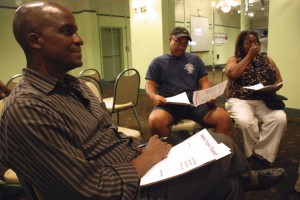For twenty years, the First Presbyterian Church has been serving dinner at its soup kitchen in Jamaica, Queens. Every Wednesday night, locals line up for baked chicken or macaroni, and recently, their numbers have been steadily increasing.
Reverend Patrick O’Connor estimates that attendance numbers are up about 20 percent from just a few months ago. But as the number of diners grow, the soup kitchen’s funding isn’t.
“As the demand increases, all the funding sources have gone in the opposite direction,” explained Reverend O’Connor. “Demand is outstripping resources, and we have to wonder – is there a breaking point?”
While times are tough, after spending a Wednesday afternoon with the soup kitchen volunteers, you wouldn’t know it. Each week, a group of five to 10 men and women gather in the back of the church and start cooking. Their laughter echoes throughout the building as their small stereo blares gospel music down the halls.
Instead of hearing worries or complaints, jokes fly as volunteers chop tomatoes and scrub pans. Although one of their busiest events – Thanksgiving – is just around the corner, they show no signs of concern that decreasing funds will impact their ability to deliver.
“We’ve never closed on a soup kitchen yet,” Jeanne Bryant, the soup kitchen team leader, said. “Our minister wouldn’t let us. It’s just not allowed.”











